

Avec cette écharpe il devient impossible de vous photographier ! Vous êtes traqué par les paparazzis, ou bien vous en avez marre d'être espionné par des caméras de surveillance ?

Devenez invisible ! Ce foulard "magique" vous permet de disparaître littéralement sur les photos et vidéos. A 28 ans, Saif Siddiqui est le concepteur de ce tissu révolutionnaire ! Le foulard Ishu permet de vous rendre invisible sur les photos et les vidéosurveillances lorsque celles-ci utilisent un flash, afin de mieux protéger votre vie privée (si tant est que vous soyez poursuivi par des paparazzis en permanence). Ce foulard est fabriqué à partir d'un tissu spécial, contenant des milliers de cristaux nano-sphériques, qui réfléchissent la lumière des flash d'appareils photo ou des caméras à l'extrême.
Pour le moment, cette innovation fait un carton à Hollywood, auprès des stars de cinémas ou encore de joueurs de football, désireux de préserver leur vie privée. Vous nous aimez déjà ? These Tiny Nanobots Can Automatically Sense And Repair Broken Electronic Circuits Too Small For Us To See. The next big revolution in science may come from the world of the very small.

Scientists Develop "Thirsty" Nanopore Water Filtration Device. Water is the most important substance to humans, by far.
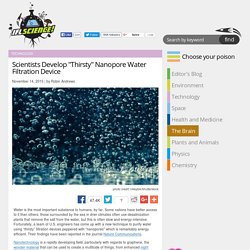
Some nations have better access to it than others; those surrounded by the sea in drier climates often use desalinization plants that remove the salt from the water, but this is often slow and energy-intensive. Welcome. Researchers Create First Single-Molecule Diode. Self-Propelled Micro-Motors Tested In A Living Animal For The First Time. For the first time, tiny artificial motors have voyaged through the body of a living animal, successfully delivering a cargo of nanoparticles directly into the stomach wall.
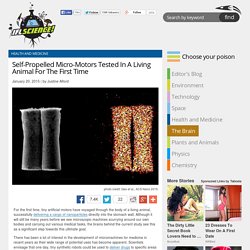
Although it will still be many years before we see microscopic machines scurrying around our own bodies and carrying out various medical tasks, the brains behind the current study see this as a significant step towards this ultimate goal. There has been a lot of interest in the development of micromachines for medicine in recent years as their wide range of potential uses has become apparent. Scientists envisage that one day, tiny synthetic robots could be used to deliver drugs to specific areas of the body to treat various medical conditions, repair damaged tissues such as blood vessels, or even manipulate individual cells.
To find out whether this could indeed be the case, the researchers tested out their micromotors on whole organisms for the first time. MIT: Synthetic DNA Can Be Used as Ink for Nanoscale 3D Printers. New cancer-hunting ‘nano-robots’ to seek and destroy tumours. It sounds like a scene from a science fiction novel – an army of tiny weaponised robots travelling around a human body, hunting down malignant tumours and destroying them from within.
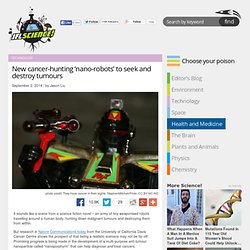
But research in Nature Communications today from the University of California Davis Cancer Centre shows the prospect of that being a realistic scenario may not be far off. Promising progress is being made in the development of a multi-purpose anti-tumour nanoparticle called “nanoporphyrin” that can help diagnose and treat cancers. Cancer is the world’s biggest killer. In 2012, an estimated 14.1 million new cancer cases were diagnosed and around 8.2 million people died from cancer worldwide. This year, cancer surpassed cardiovascular diseases to become the leading cause of death in Australia; 40,000 Australians died as a result of cancer last year. DARPA’s New Initiative Aims to Make Nanoscale Machines a Reality. For much of history, builders and makers fixated on the monumental—pyramids, cathedrals, skyscrapers, aircraft carriers.

Increasingly, however, the cutting edge focus is smaller. Much smaller. The field of nanotechnology aims to build components or even entire machines so small they approach the atomic. Tiny machines may cruise our bodies selectively releasing drugs, repairing cells, or hunting pathogens. Nanotechnology may yield materials with amazing new properties. Though nanotechnology is advancing, there is not yet a consistent, economical method of assembly. In addition to learning to better build nanoscale components and machines, DARPA is interested in making materials that exhibit useful nanoscale properties on human scales. New Super Black Material Absorbs 99.965% Of Light. Researchers Reveal Smallest, Fastest Nanomotor Yet. Nanotechnology in medicine promises targeted drug delivery while not harming healthy cells.
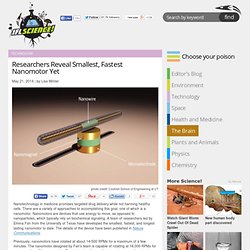
Regenerating Plastic Oozes Clot-Like Goo. Plastics capable of regeneration have been announced in Science.
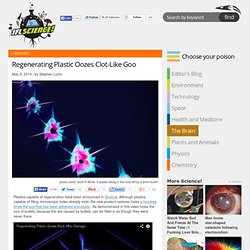
Although plastics capable of filling microscopic holes already exist, the new product restores holes a hundred times the size that has been achieved previously.. As demonstrated in this video holes the size of bullets, because the are caused by bullets, can be filled in as though they were never there. "We have demonstrated repair of a nonliving, synthetic materials system in a way that is reminiscent of repair-by-regrowth as seen in some living systems," said Professor Jeffrey Moore of the University of Illinois. The team report filling a 35mm hole in 20 minutes, with mechanical function restored in 3 hours, although the have restricted their claims of reliable performance to 9mm. Scientists Make Headway Toward Invisibility Cloaking. The world of science fiction is rife with examples of invisibility - whether it is Harry Potter’s cloak, Romulan cloaks integrated into a spaceship’s shields, or the One Ring that helped our favorite hobbits steer clear of orcs.
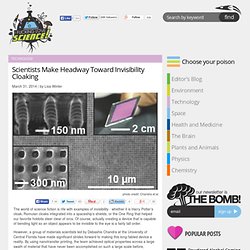
Of course, actually creating a device that is capable of bending light so an object appears to be invisible to the eye is a fairly tall order. However, a group of materials scientists led by Debashis Chandra at the University of Central Florida have made significant strides forward to making this long-fabled device a reality. Spray-On Nanofibres Bind Surgical Wounds. Polymer nanofibres can be sprayed onto surgical incisions, sealing them to prevent infection.
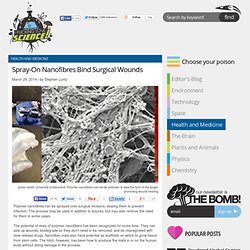
The process may be used in addition to sutures, but may also remove the need for them in some cases. The potential of mats of polymer nanofibers has been recognized for some time. They can seal up wounds, biodegrade so they don't need to be removed, and be impregnated with slow release drugs.